1. Introduction
In this report, Syrians for Truth and Justice (STJ) sheds light on the phenomenon of infant abandonment, which has been escalating since the conflict began in Syria. Field researchers with STJ recorded over 100 new cases of child abandonment between early 2021 and late December 2022.
Geographically, infants were deserted in all territories of control. Cases were recorded in Idlib province—the majority of which is controlled by Hay’at Tahrir al-Sham (HTS), in the countryside of Aleppo province—controlled by the Turkey-backed Syrian National Army (SNA) of the Syrian Interim Government (SIG), in northeastern Syria—controlled by the Autonomous Administration (AA), in areas controlled by the government of Syria (GOS)—including Rif Dimashq (Damascus countryside).
STJ mapped out the registered cases:
- In HTS-held areas: There were at least 13 cases in Jisr al-Shughur, Ariha, Ma`arat al-Nu`man, and Idlib city.
- In SNA-held areas: There were at least 11 cases in Afrin, al-Bab, Azaz, and Mare’.
- In AA-held areas: There were at least 19 cases in al-Hasakah, Deir ez-Zor and Raqqa.
- In the GOS-held areas: There were at least 21 Most of the cases were recorded in Rif Dimashq (Damascus countryside), followed by Homs, Hama, Aleppo, and Daraa.
Notably, GOS-affiliated bodies documented other cases. On 12 May 2022, the Director-General of the Syrian Forensic Medicine Authority, Zaher Hajjo, made a statement to the al-Watan newspaper, which is often aligned with the GOS.[1] He revealed that the authority had recorded at least 38 child abandonments since the beginning of 2022 and up to 12 May.
Notably, the new figures demonstrate that the phenomenon not only remains rife in Syria but is only worsening. In a 2020 report, STJ documented at least 43 cases of newborns abandoned in Idlib and Aleppo’s countryside between the beginning of 2019’s second half and the end of 2020’s first half. Moreover, in a 2019 report, STJ registered at least 40 cases in Idlib and the northern countryside of Aleppo, which occurred over 2018 and the first half of 2019.
For the purposes of this report, STJ interviewed 18 sources. STJ met three of the interviewees in person and reached out to the other 15 online between October and December 2022.
Among the interviewees were 13 eyewitnesses or foster parents, who took infants abandoned in HTS and SNA-held areas into their care. Notably, STJ could not establish communication with similar eyewitnesses or foster families in GOS or AA-held areas even though these areas also are beset by infant abandonment.
Additionally, STJ reached out to two child protection workers whose teams operate in Idlib and Aleppo’s countryside, two Idlib-based orphanage staffers, and several activists who are informed of the situation in their provinces.
Moreover, STJ obtained exclusive commentary from a source within the Office for the Protection of Children in Armed Conflicts of the Autonomous Administration.
2. Child Abandonment in HTS-Held Areas
Researchers with STJ registered a marked rise in child abandonment in the parts of Idlib province that HTS controls. Over the time covered by the report, the researchers documented at least 13 cases in several towns and villages across the province, including Ariha, Jisr al-Shughur and Ma`arat al-Nu`man. Locals from these areas found the infants on roadsides, near mosques or hospitals, or in garbage dumps.
2.1. He was Only a Few Hours Old
At dawn on 19 January 2021, the residents of the al-Qusour neighborhood in Idlib city found a newborn relinquished near a school. For the details of the incident, STJ reached out to one of the residents who found the abandoned infant. The witness narrated:
“On my way home, one of the neighborhood’s residents asked me to help him open a bundled blanket dumped close to al-Mutanabbi School. The screams of a newborn could be heard coming out of it. When we opened the bundle, we found a baby boy, completely naked with the afterbirth still on his body. We rushed him to the city hospital. However, the hospital refused to take him in unless the security forces were present. The forces showed up after about an hour and a half. The doctors said that the infant’s body temperature was abnormally low, and he would have been in danger had it not been for first aid. Later, I learned that the baby was admitted into an orphanage.”
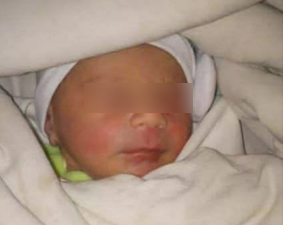 Image (1)- The infant found abandoned near a school in Idlib city. Source: Local social media pages.
Image (1)- The infant found abandoned near a school in Idlib city. Source: Local social media pages.
2.2. He was Abandoned on a Roadside
On 11 January 2021, residents of the al-Souq neighborhood in Ariha city, in Idlib’s countryside, found a newborn baby boy abandoned on the side of the road. For details on the baby’s fate, STJ talked to one of the residents. He recounted:
“The [residents] handed over the baby to the HTS-affiliated police station in the town. In turn, the station sent him to the city’s hospital. Doctors there confirmed that the baby was less than 24 hours old. The child remained in the hospital for five days until an orphanage in Sarmada city took him in.”
2.3. She was Wrapped in Shreds
On the evening of 22 June 2021, residents of a camp for internally displaced persons (IDPs) in Hazano village in Idlib’s countryside found a newborn girl wrapped in a blanket and abandoned near a mosque. Inquiring into the incident, STJ reached out to an IDP from the village’s camp, who today fosters the little girl. He narrated:
“When I unwrapped the cover, I found a newborn baby girl. She was dressed in a tattered clothes. With several people from the camp, I took the baby to the makeshift clinic to check on her health. The doctors there confirmed that she was no more than five days old and that she was in dire need of milk. They told me they would refer her to an orphanage in Sarmada, but I decided to foster this child despite my age. The next day, I went to the Sharia court, which approved that I become her kafil (guardian). I decided to name her Hiba (a blessed gift). I took her to my daughter-in-law to breastfeed her.”
2.4. She was Left Under a Tree
At noon on 1 November 2021, the residents of Qmenas village, in Idlib’s countryside, found a child under a tree near the main road. STJ spoke to Walid al-Ketarmawi, a pharmacist from the village, who examined the baby girl before she was transferred to the hospital. He narrated:
“On that day, several people from the neighborhood came to my place and asked me to examine a newborn girl they had found. The little girl’s body was bluish due to extreme cold and hunger. Therefore, we immediately took her to the town’s hospital. There, [the doctors] said that she was suffering from dehydration. She remained in the hospital for five days until her condition improved. She was then sent to an orphanage in [Idlib] province.”
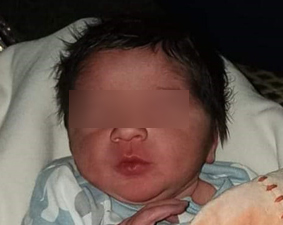 Image (2)- The infant found abandoned in Qmenas village, in Idlib’s countryside. Source: Local social media pages.
Image (2)- The infant found abandoned in Qmenas village, in Idlib’s countryside. Source: Local social media pages.
2.5. She was Abandoned Near a Mosque
At dawn on 15 August 2021, residents in Idlib city found a newborn girl wrapped in a cover at the entrance to a mosque. STJ reached out to the man who fostered the baby girl:
“With the baby girl, I found a piece of paper. The note said, ‘This is my daughter, but I do not have the means to raise her. Her father and mother are lawfully married’. I immediately took the baby home. My wife took care of her. Then, we decided to foster her. She is now over a year old. She has become an essential member of my family.”
2.6. She was Found in a Plastic Bag
On the morning of 6 February 2022, a resident of Ariha city found a newborn baby girl abandoned in a plastic bag near the bakery where he works. He narrated:
“I was surprised by a plastic bag left near the bakery where I work. When I opened it, I was shocked to see a newborn girl. I immediately took her to the hospital. [The doctors said] that she was in poor health due to the cold weather. The hospital informed the police station, which sent the child to an orphanage.”
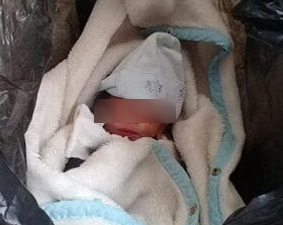 Image (3)- The infant found abandoned near a bakery in Ariha city. Source: The bakery worker who found the baby girl.
Image (3)- The infant found abandoned near a bakery in Ariha city. Source: The bakery worker who found the baby girl.
2.7. He was Only Two Months Old
On 14 July 2022, a child protection team found an infant abandoned on a roadside in Ma’arrat Misrin town, in Idlib’s countryside. For a comment on the incident, STJ reached out to a team member, Samar al-Mahmoud. She narrated:
“Our team received a report about a baby boy abandoned on the side of the road to Sheikh Bahr [IDP Camp]. According to the report, two people riding a motorcycle left the baby there. We went to the house of a man who took care of the infant until we arrived. He watched over him for several hours. We estimated the baby’s age to be about two months. We handed him over to one of the orphanages in Sarmada city.”
2.8. Fear Shrouds the Infants’ Futures
Several orphanages take care of abandoned infants in Idlib. However, the administrations of these shelters often have little to no control over the challenges facing the futures of their unfortunate residents.
For insights on the status of the infants, STJ reached out to staffers from two Idlib orphanages. They highlighted the administrative and emotional challenges that abandoned children often face.
STJ interviewed Murad al-Idilbi, the director of the First Care Home for Orphans in Idlib’s countryside. Al-Idilbi said that the home had admitted 36 abandoned children since 2018.
Beyond the shocking number, al-Idilbi expressed extreme concern for the children, saying that despite the care that the home seeks to offer to these children, their future remains worrying. He pointed out that several children do not possess any documents proving their identities even though they are five years old.
He stressed that these children are denied identification documents because the local authorities do not allow the orphanage to register them at Idlib’s civil registries. He added that this situation is exacerbated by the fact that orphanages cannot register the children at GOS-affiliated personal status departments. These departments are in GOS-held areas, and going there might put staffers at risk of arrest by the GOS’ security services.
STJ also met with Shaher al-Issa, a worker with the House of the Children in Idlib. Al-Issa said the house had admitted 28 abandoned children, who are five to six years old, since 2020. Sharing al-Idilbi’s fear for the future of the children, al-Issa narrated:
“One of the difficulties we face in dealing with the children is that they often miss intimacy. They always give each other trouble, which presents us with a huge challenge. There is no clear vision for the future of these children after they turn 15. We cannot tell if the house will still exist by then or whether these children will remain in the care of the house until then. We do not have a clear idea about the prospects of these children.”
2.9. Inefficient Official Measures
While abandoned children struggle with prospective statelessness, the response measures de facto authorities have established remain deficient. These measures fail to address the phenomenon of infant abandonment and do little to improve the status of children forsaken by their parents.
The measures are limited to admitting the children into orphanages or into the protection of families volunteering to foster them. However, the authorities have not taken any action to ensure that these children are afforded the least of the civil rights they are entitled to, such as registration with local civil registries.
For a comment on the measures the authorities take after finding an abandoned infant, STJ interviewed a media activist informed of the situation. The activist said:
“[The person or entity who finds an abandoned child] first reports the incident to the police station in the area. The station then refers the file of the child to the sharia court. When a family applies to foster the child, the parents resort to the sharia court. There, they initiate the kafala (guardianship) process,[2] pledging to take care of the child. Kafala measures include that foster parents swear not to give the child their family name and not to tell him/her that he/she is a foster child until he/she reaches maturity. However, in the case that no family applies to foster the child, the court sends the child to an orphanage.”
3. Child Abandonment in SNA-Held Areas
Over the period covered by this report, field researchers with STJ documented at least 11 cases of child abandonment in several towns and villages across Aleppo’s countryside, including Afrin, al-Bab, and Azaz.
3.1. She was Never Even Breastfed
On the morning of 20 September 2021, residents in Qabtan village, in the Akhtarin area, found a newborn girl abandoned near the village’s mosque. For details on the incident, STJ reached out to one of the villagers. He narrated:
“We took the child to the hospital. The doctors told us that the baby girl was born 24 hours ago and was never breastfed. Her parents remain unidentified. She stayed in the hospital for nearly 48 hours and was then transferred to an orphanage.”
3.2. He was Critically Ill
In al-Bab city, locals found an abandoned newborn baby boy in early April 2022. Commentating on the incident, one of the doctors who examined the infant after he was found recounted:
“The child was in poor health. He was starving and cold. He also had severe diarrhea that could have killed him had not the people rescued him at the last minute. The child was found in front of the door of a charity in the city. He remained in the hospital for ten days before one of the villagers applied to foster him.”
3.3. She was Abandoned Near a School
In mid-August 2022, locals in Amara village in the Afrin region found a newborn baby girl near the village’s school.
Investigating the baby’s fate, STJ reached out to one of the village’s media activists. He recounted that the people reported the incident to the local council. He added that the baby was taken to a hospital and later admitted to one of the area’s orphanages.
3.4. Actual Numbers Higher Than Recorded
Investigating the underlying causes of child abandonment in these areas, STJ interviewed Nadiya al-Samsoum, a worker with a child protection team operating in Idlib and Aleppo’s countryside. Al-Samsoum said that poverty is the primary reason why parents are abandoning their infants, adding:
“Over 2021 and 2022, our team recorded at least 63 cases of child abandonment in Idlib and areas north of Aleppo province. Out of these, 39 were already dead when they were found. Notably, the real figures might be higher than those recorded, especially because some people do not report finding children and keep them secretly. The circumstances accompanying displacement and financial hardships have increased child abandonment in one way or another—especially since poverty rates continue to rise. These conditions have forced some parents to abandon their children because they cannot afford to raise them financially.”
Al-Samsoum highlighted the other factors contributing to inflating the phenomenon, which her team detected in 20% of the cases they documented. In these cases, the babies are born to unmarried parents or to sexually abused women. She added that with strict security and medical censorship on abortions at hospitals, several women are forced to see their pregnancies through, only to abandon the babies once they are born.
3.5. Authorities in Aleppo’s Countryside are Equally Passive
Monitoring official responses in Aleppo’s countryside, STJ observed similar limitations in the role SNA-affiliated authorities play. These authorities either relocate found children to orphanages or put them in the care of interested foster families.
The same activist STJ met in Idlib said that the files of children found in Aleppo’s northern countryside are referred to the sharia court of the SIG. The court then decides whether to put the child in the care of a family or in an orphanage. However, abandoned infants, like their peers in Idlib, are denied access to registration in civil registries and thus are threatened with statelessness.
4. Child Abandonment in AA-Held Areas
A large number of the cases registered over the report’s period occurred in AA-held areas. Field researchers with STJ documented at least 19 cases in al-Hasakah, Deir ez-Zor, and Raqqa.
4.1. She Still Displayed the Marks of Labor
On the morning of 12 July 2022, locals in the suburbs of Markada district, south of al-Hasakah, found a newborn girl dumped on a roadside. Recounting the details of the incident, the director of the Komin (Commune/local administration) in the area said:
“The baby girl was found abandoned near the village’s school. Only hours had passed since she was born, and her body was still covered with the afterbirth. I went to the center of the Internal Security Forces (Asayish) in Markada district immediately and made a detailed report about the incident. It turned out that the child was born in Markada district, where a man and a woman sought a midwife using fake names. After the birth, the baby girl was left on the roadside.”
The director said that he did not admit the baby into an orphanage and chose to foster her until her parents or other relatives were identified. He added that the baby is now several months old and that he calls her Hibatullah (A blessing from God).
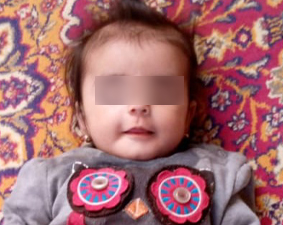 Image (4)- The infant found in Markada district. Source: The foster family.
Image (4)- The infant found in Markada district. Source: The foster family.
4.2. He was Less than a Day Old
On the morning of 24 April 2021, locals in Qamishli/Qamishlo city found a newborn baby boy abandoned in front of the Al-Rahma House for Orphans. For comment on the incident, STJ reached out to the director of Al-Rahma House, Intisar al-Ali. She recounted:
“It was clear that only a few hours had passed since his birth. We informed the concerned authorities. After the police made their report about the incident, the baby boy was transferred to a hospital to receive necessary treatment and then returned to [Al-Rahma House for Orphans]. He is now six months old and no one has so far claimed him.”
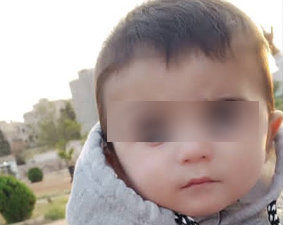 Image (5)- The baby found in Qamishli/Qamishlo city. Source: Director of the Al-Rahma House for Orphans.
Image (5)- The baby found in Qamishli/Qamishlo city. Source: Director of the Al-Rahma House for Orphans.
Unlike abandoned children in Idlib and rural Aleppo, children in AA-held areas have access to registration in civil registries. In an exclusive interview with STJ, a source from the Office for the Protection of Children in Armed Conflicts of the Autonomous Administration relayed the measures authorities follow upon finding a child. On the condition of his anonymity, the source said that the police first make a report about the incident. After this, a forensic doctor or a medical committee examines the child to ensure he/she is well and unharmed. Based on the medical assessment, the child is sent either to a hospital or directly to an orphanage, where he/she remains until he/she has completed university education. The source added that, in cooperation with the Red Crescent, children are registered in the GOS’s civil status departments.
5. Child Abandonment in GOS-Held Areas
Similar to AA-held areas, the GOS-controlled areas witnessed a significant increase in child abandonment cases during the period the report covers. Field researchers with STJ documented at least 21 cases in Rif Dimashq, Homs, Hama, and Daraa.
Notably, GOS-affiliated bodies documented other cases. On 12 May 2022, the Director-General of the Syrian Forensic Medicine Authority, Zaher Hajjo, made a statement to the al-Watan newspaper, which is often aligned with the GOS.[3] He revealed that the authority had recorded at least 38 child abandonments since the beginning of 2022 and up to 12 May. The cases included 21 boys and 17 girls.
One of the cases STJ documented occurred in the al-Sahari neighborhood in Daraa city. Locals found a newborn girl wrapped only in a piece of cloth and left near a bakery on 31 May 2022. An activist from the area told STJ that the baby was taken to Daraa National Hospital for treatment because she had a high fever and was then admitted to a children’s home in Rif Dimashq.
The activist said that locals in the al-Kashef neighborhood in Daraa city found another abandoned infant on 27 April 2021. The baby boy was left in front of a building, and the locals estimated his age at less than a month. The locals surrendered him to the GOS-affiliated police department.
A third case was documented in Rif Dimashq on 26 May 2022. Locals in Muadamiyat al-Sham town found a newborn baby wrapped in a piece of cloth with a note saying: “The mother died in childbirth.” The baby was handed over to the concerned authorities according to a Facebook post on the official page of the Syrian Ministry of Interior.[4]
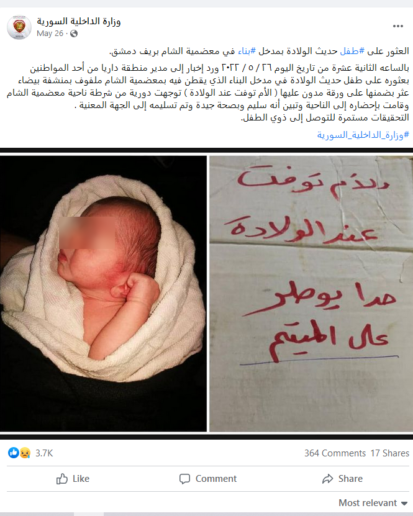 Image (6)- Screenshot of the interior ministry’s Facebook post.
Image (6)- Screenshot of the interior ministry’s Facebook post.
Notably, in GOS-controlled areas the measures set up to address the cases of abandoned children ensure that their status as children of unknown parentage remains confined to official records. When an infant is found, the concerned police station makes a report about the case and then refers it to the Public Prosecution. The Public Prosecution sends the child to the designated center in the Ministry of Social Affairs and Labor. Then, the child’s health is examined. After that, the civil registry registers the child, choosing his/her name, parents’ names, and family name. Additionally, it is prohibited for anyone —except the civil registry— to know that the child is of unidentified lineage. Owing to this registration mode, the child is guaranteed access to his/her civil rights.[5]
6. Legal Opinion
Even though the phenomenon of child abandonment has inherently major social and psychological consequences to the child, which alone should inhibit its spread, Syrian laws take a firm prohibitory stance towards the action. Under the law, the primary responsibility rests with the parents. It is the duty of the parents to nurture the child and raise him/her to be a self-reliant individual, capable of positively influencing his/her surroundings in the future. Building on this responsibility, the Syrian Penal Code considers leaving a child without a breadwinner a punishable crime. The criminalization of child abandonment is established in the code’s Articles 484 and 486.
Article 484 states that “Whoever abandons or neglects a child under seven years of age or any other person who is incapable, by reason of his physical or mental condition, of looking after themselves, is liable to a term of imprisonment of three months to one year. Should the child be abandoned in a deserted place, the prison term will vary between one and three years.”
Article 486 aggravates the penalty if the offender is an ascendant of the child or an incompetent individual or a person entrusted with his/her care, supervision, treatment, or education.
Notably, legal researchers with STJ believe that while these texts criminalize child abandonment, they could be improved. The code applies criminalization to abandonment as long as the child involved is seven years old or younger, while criminalization should be sustained as long as the child is under 18 years old.[6]
Additionally, the code absolves the mother from punishment if she had neglected or abandoned her child in an effort to avoid social stigma or protect her honor. This is established in the second paragraph of Article 486, which states that the penalty text does not apply to the mother who instigates, perpetrates, or partakes in the abandonment of her newborn to protect her honor. This exemption is unacceptable because the law risks the child’s life to sustain social customs and norms, which are irrelevant to the child and which he/she is not responsible for.
While Syrian laws identify that parents, in terms of liability, are at the heart of the act of abandonment, STJ’s legal researchers stress that responsibility is not exclusive to them and does not, in any way, exempt the State from its duties toward the issue. Therefore, if parents are unable or cannot afford to raise a child for any reason, the State is obliged to find solutions that consider the interests of the child. This obligation is rooted in Article 20 of the effective 2012 Syrian Constitution. The article states that:
“1- The family shall be the nucleus of society and the law shall maintain its existence and strengthen its ties;
- The state shall protect and encourage marriage, and shall work on removing material and social obstacles that hinder it. The state shall also protect maternity and childhood, take care of young children and youth and provide the suitable conditions for the development of their talents.”
However, this article, like many articles in the Syrian constitution, remains a theory rather than a practice. If the GOS was practically following the article’s guidelines, we likely would not have seen increasing cases of child abandonment in GOS areas over the past few years. The failure of the GOS to implement the article’s guidelines is evident in the GOS’s weak response to the cases this report documents, as the government has taken few measures to meaningfully protect the interests of children in areas under its control.
Notably, the same duties bind the de facto authorities in areas outside the control of the GOS. These authorities have to abide by their self-imposed obligatory laws and regulations. For instance, in SNA-held areas, the SIG-founded courts function by Syrian law. Therefore, the legal frames binding to the GOS are equally obliging to the SIG, which claims jurisdiction over Afrin, al-Bab, Ras al-Ayn/Serê Kaniyê, and Tal Abyad regions.
In AA-held areas—encompassing al-Hasakah, Raqqa, and Deir ez-Zor, active authorities must fulfill their duty of supporting children’s care and upbringing, when parents are unable to do so themselves, and especially in the case the parents are altogether unidentified, which is the situation of the children whose stories the report tells. This obligation is established in the Charter of the Social Contract the AA issued in 2014. The charter guarantees the right to childhood and the protection of motherhood and childhood (Articles 29 and 30).
Notably, the obligations enshrined by national laws are reiterated across several covenants and treaties, including the Convention on the Rights of the Child of 1989. The Convention necessitates that the best interests of the child be a primary focus. Article 3 of the Convention states that:
“1. In all actions concerning children, whether undertaken by public or private social welfare institutions, courts of law, administrative authorities or legislative bodies, the best interests of the child shall be a primary consideration;
- States Parties undertake to ensure the child such protection and care as is necessary for his or her well-being, taking into account the rights and duties of his or her parents, legal guardians, or other individuals legally responsible for him or her, and, to this end, shall take all appropriate legislative and administrative measures;
- States Parties shall ensure that the institutions, services and facilities responsible for the care or protection of children shall conform with the standards established by competent authorities, particularly in the areas of safety, health, in the number and suitability of their staff, as well as competent supervision.”
[1] “Forensic Medicine Authority Recorded 38 Foundling Cases This Year: Damascus’s Countryside Ranked First with Nine Cases while Quneitra Registered None” (in Arabic), al-Watan, 12 May 2022 (Last visited: 24 December 2022). https://alwatan.sy/archives/303127
[2] For further information on adoption measures in Syria, see: “Adoption in Syria”, STJ, 2 March 2022 (Last visited: 25 December 2022). https://stj-sy.org/en/adoption-syria/
[3] “Forensic Medicine Authority Recorded 38 Foundling Cases This Year: Damascus’s Countryside Ranked First with Nine Cases while Quneitra Registered None” (in Arabic), al-Watan, 12 May 2022 (Last visited: 24 December 2022). https://alwatan.sy/archives/303127
[4] The official Facebook account of the Syrian Ministry of Interior, 26 May 2022 (Last visited: 26 December 2022). https://www.facebook.com/264301457287719/posts/pfbid0dyYfCN4DB3FfDXHjRMmWzXwF23JowtFZfjC1qdGkQrWcnqh6qtNugHW8BPd32Xfzl/?d=n&mibextid=0x7PCD
[5] “The Civil Registry Picks Names of Child and Parents: 300 Children of Unknown Parentage Registered during the Crisis; They Enjoy their Civil Rights and their Status shall be Revealed only before the Judiciary” (in Arabic), al-Watan, 19 March 2018 (last visited: 26 December 2022). https://alwatan.sy/archives/143738
[6] See Article 1 of the Law 18 Of 1974 Juvenile Delinquents Act and Article 1 of the Convention on the Rights of the Child of 1989.

